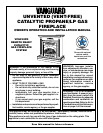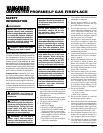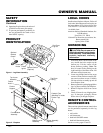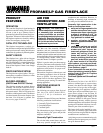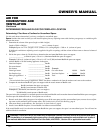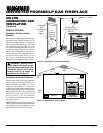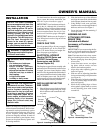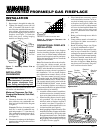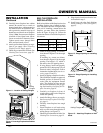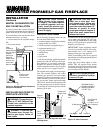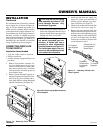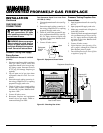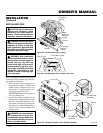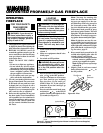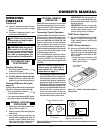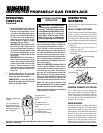
8
104637
UNVENTED
PROPANE/LP
GAS FIREPLACE
®
Figure 9 - Placing Hearth Base Accessory
Against Wall
Figure 10 - Installing Cabinet Mantel
Electrical
Outlet
Hearth
Base
Flexible
Gas Line
Gas Line
Access
Hole
Cabinet
Mantel
INSTALLATION
CLEARANCES
WARNING: Maintain the mini-
mum clearances. If you can, pro-
vide greater clearances from
floor, ceiling, and adjoining wall.
CONVENTIONAL FIREPLACE
INSTALLATION
Conventional installation of this fireplace
involves installing fireplace along with the
corner, face, or cabinet mantel with hearth
base accessories against a wall in your home.
Follow the instructions below to install the
fireplace in this manner.
Note:
The instructions below show installa-
tion using the cabinet mantel and the
G3000F/G3001U/G3004W/G3006F/
G3007U series hearth base accessories. The
hearth base accessory shown is optional for
this installation. You can install fireplace
and cabinet/corner mantel directly on the
floor. The corner mantel accessory cannot
be installed with the G3000F/G3001U/
G3004W/G3006F/G3007U hearth bases.
The conrner mantel can be paired with the
G3008F/G3009U/G3010F corner hearth
base. If mounting fireplace and cabinet or
corner mantel to the floor, an optional G3005
Slim Base kit may be installed.
1. Assemble cabinet mantel, hearth base,
and trim accessories. Assembly instruc-
tions are included with each accessory.
2. When installing blower, install a prop-
erly grounded, 120 volt three-prong
electrical outlet at fireplace location if
an outlet is not there. If possible, lo-
cate outlet so cabinet mantel will cover
it when installed (see Figure 9).
3. Install gas piping to fireplace location. This
installation includes an approved flexible
gas line (if allowed by local codes) after
the equipment shutoff valve. The flexible
gas line must be the last item installed on
the gas piping. See Installing Gas Piping
to Fireplace Location, page 10.
INSTALLATION
Continued
4. Place hearth base accessory against
wall at installation location. Cut an ac-
cess hole in hearth top to run gas line
to fireplace (see Figure 9). Make sure
to locate access hole so cabinet mantel
will cover it when installed.
Note:
You
can secure base to floor using wood
screws. Countersink screw heads and
putty over.
5. Route gas line through access hole in
hearth base.
6. Center cabinet mantel on hearth base
(see Figure 10). Make sure mantel is
flush against wall.
7. Break off nailing flanges (see Figure
11, page 9) with hammer or pliers.
8. Place cardboard or other protective ma-
terial on top of hearth base. Carefully
set fireplace on protective material, with
back of fireplace inside mantel opening.
9. If blower is installed, route blower elec-
trical cord through access holes in ei-
ther side of fireplace.
Note:
Bushing
may be moved if necessary. Plug elec-
trical cord into electrical outlet.
Figure 7 - Attaching Brass Trim to
Fireplace
Trim
Hanging
Screws
Assembled
Brass Trim
Hanging
Notches
on Trim
7. Repeat steps 1 through 6 for other side.
8. Tighten trim hanging screws (#10-16
with .25 shoulder) into holes in cabi-
nets. Place the assembled trim onto fire-
place cabinet. Align hanging notches
on trim with hanging screws on side of
fireplace (see Figure 7). Push trim
firmly into place, sliding hanging
notches over hanging screws.
Carefully follow the instructions below. This
will ensure safe installation.
Minimum Clearances For Side
Combustible Material, Side Wall,
and Ceiling
A. Clearances from the side of the fire-
place cabinet to any combustible ma-
terial and wall should follow diagram
in Figure 8.
Example:
The face of a mantel, book-
shelf, etc. is made of combustible ma-
terial and protrudes 3
1
/2" from the wall.
This combustible material must be 4"
from the side of the fireplace cabinet
(see Figure 8).
B. Clearances from the top of the fireplace
opening to the ceiling should not be less
than 42 inches.
Figure 8 - Minimum Clearance for
Combustible to Wall
.5 2
7/16
7/8
1
3
/
4
3
1
/
2
5
1
/
4
7
8
3
/
4
10
1
/
2
12
1
/
4
1 4 6 8 10 12 14 16
FIREBOX
INCHES
INCHES
*Minimum 16 inches from Side Wall
*
Example



